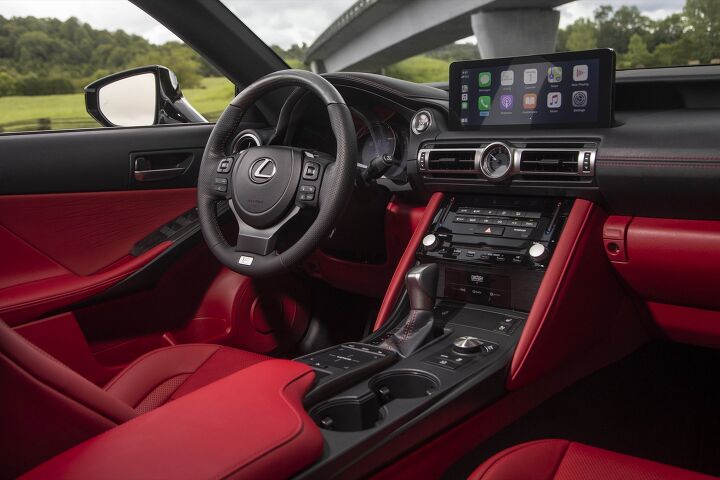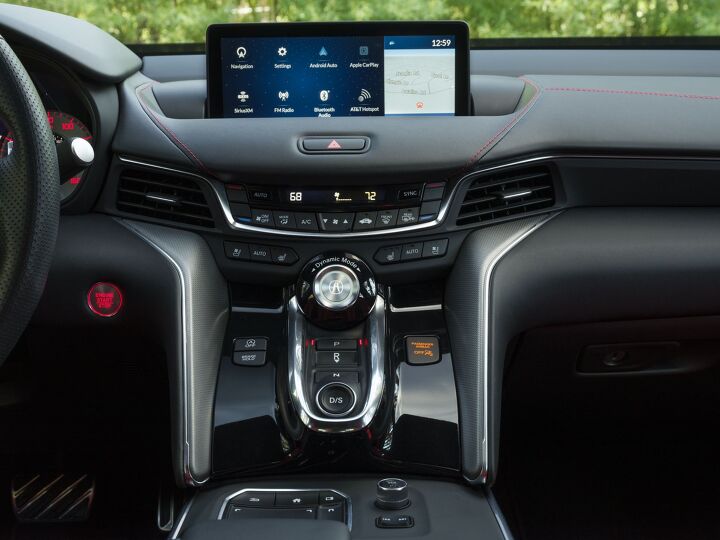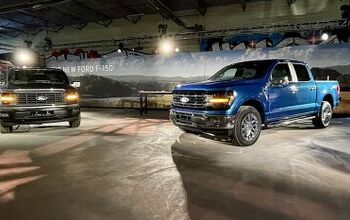Acura TLX Vs Lexus IS: Which Japanese Luxury Sedan is Right for You?


The default choices in the compact luxury sedan market are all German. But if you want something that stands out, what about the Acura TLX and Lexus IS?
These two Japanese four-doors represent two different takes on the segment. The Lexus IS debuted over 20 years ago as a veritable BMW 3 Series fighter, with a similar inline-six powertrain and rear-wheel drive. For 2021, Lexus significantly re-engineered its sport sedan. Rear-wheel drive is still on the menu, plus available all-wheel drive, with a modernized interior and fresh styling to match.
Get a Quote on a New Acura TLX or Lexus ISAcura debuted the second-generation TLX for 2021 as well. The latest evolution of the car formerly known as the TL, the TLX now stands atop the Acura sedan lineup, as the unloved RLX disappeared last year. Larger than the Lexus, the Acura promises a renewed focus on dynamic prowess, specifically with the reborn Type S.
Which one of these funky Japanese sport sedans is a better fit for you? Read on for all the details.
Cabin Space

TLX: The TLX features a highly stylized dashboard design, with the focus on the big drive mode rotary selector smack in the middle. The Acura has a push-button shifter as well, sitting just below that selector. The center console is largely dedicated to the infotainment controls, which we’ll get to in a later section.
Tall drivers, be warned: the TLX will be tighter for your noggin, with 37.2 inches (946 mm) of headroom up front, and 36.3 inches (921 mm) out back. The Acura’s 42.5 inches (1,079 mm) of front legroom can’t match the Lexus, but it makes up for it with 34.9 inches (886 mm) in the rear. It also wins on the shoulder room front, at 58.2 and 55.0 inches (1,478 and 1,396 mm) front and back.

IS: By comparison, the Lexus is much more conservative, even when both of the interiors are bright red. There’s an analog clock right there on the dashboard, for instance. Just below the old-school time-teller is a variety of physical buttons for climate controls as well as the audio—and yes, that is a CD player.
Front-row passengers will find an extra inch (25 mm) of head space, totalling 38.2 inches (970 mm). Front legroom is a huge 44.8 inches (1,138 mm), while shoulder room checks in at 55.9 inches (1,420 mm). Rear-seat measurements are 36.9, 32.2, and 53.4 inches (937, 818, 1,356 mm), respectively.
SEE ALSO: 2021 Acura TLX A-Spec Review: Making the GradeBottom Line: Despite being the larger car, the TLX doesn’t hold a clear advantage over the smaller IS. The Lexus has more headroom, the two average out on legroom, and the Acura has extra shoulder space. We always recommend sitting in every seat in every car you’re considering, and it’s especially true here to find any unexpected surprises.
Cargo Space

TLX: The TLX’s cargo haul holds 13.5 cubic feet (382 L). It has a 60/40 folding rear seat.

IS: The IS also has a 60/40 folding rear seat. Storage space is down from the TLX though, at just 10.8 cubic feet (306 L).
Bottom Line: The numbers don’t lie: it’s the TLX for the win here.
Technology and Features

TLX: Every version of the TLX comes standard with a 10.2-inch infotainment screen. Note we didn’t call it a touchscreen, because it isn’t one. Acura has stuck to its center console trackpad system here, which can be tough to navigate on the move, even for passengers. Menu navigation isn’t the most straight-forward, either. The system has snappy responses though, and (wired) Apple CarPlay and Android Auto are both included.
The TLX includes dual-zone auto climate control across the board, plus power-adjustable front seats with driver memory function. Heating is also standard, though you’ll need to move up to the A-Spec for ventilation, and the Advance (Platinum Elite in Canada) for heated rears. From A-Spec onwards, the climate control can be tied to the GPS.
The Technology trim introduces the 13-speaker ELS Studio audio system. Move up to the A-Spec or above and that transforms into the ELS Studio 3D setup, with an extra quartet of speakers. It is, in a word, superb. Wireless charging shows up in the A-Spec and up as well—though curiously, the head-up display is only available on the Advance, not the Type S. Native navigation is equipped on all models bar the base TLX.

IS: The base model IS makes do with an 8.0-inch screen, but as of 2021 it’s now a touchscreen. Hallelujah! A larger 10.3-inch screen is part of a navigation package—it’s optional on the IS 300 AWD in Canada, and standard on the IS 350 AWD there). Both Android Auto and Apple CarPlay are standard, as is Amazon Alexa and SiriusXM. You’ll only find two USB ports within the IS, however.
Dual-zone climate control is standard across all models, as are eight-way power-adjustable pews in the front row. You’ll find power lumbar support added on the 350 models, too. Heated and ventilated front seats are a similar setup: optional on 300s, standard on 350s.
This being a Lexus, of course, there’s a Mark Levinson sound system on the options list. It’s a mega 17-speaker, 1,800-watt setup, sure to bring the best out of your music collection. We’ll need to have a proper listen of Queen’s A Night at the Opera in both to really know which system is best.
SEE ALSO: Acura TLX vs Audi A4 and Rivals: How Does it Stack Up?Bottom Line: The Lexus infotainment system ain’t as pretty as the Acura’s, but the move back to a touchscreen makes it so much easier to use for passengers. And there’s still the trackpad if you’d rather not be reaching to poke at a screen while driving. It misses out on the available head-up display in the Acura, though.
Both cars feature fantastic optional sound systems, so audiophiles will be happy in either.
Based on the ease of use alone, the Lexus gets the nod here.
Powertrains

TLX: Both of these cars start with a 2.0-liter turbocharged four-cylinder. The Acura has the initial power advantage, with 272 horsepower and 280 pound-feet. A 10-speed automatic handles shifting duties, sending power to the front wheels or through the optional Super-Handling All-Wheel Drive (SH-AWD) system.
Acura also re-introduced the Type S trim with the latest TLX. Available only with SH-AWD, it uses a brand-exclusive 3.0-liter turbocharged V6, pumping out 355 hp and 354 lb-ft of torque.

IS: As we mentioned, the IS lineup begins with a turbo-four, too. The IS 300 RWD has 241 hp, while torque peaks at 258 lb-ft. Despite the power deficit, it still requires premium fuel. Opt for the IS 300AWD, however, and Toyota swaps in a detuned version of its 3.5-liter V6. Power is up to 260 hp, but torque is down to 236 lb-ft, and peaks later in the rev range.
The IS 350 uses the V6 at full power: 311 hp, and a TLX-matching 280 lb-ft of torque (at a much higher 4,800 rpm).
Opting for either 300 or 350, rear-drive models use an eight-speed automatic transmission, while AWD is saddled with an older six-speed auto.
Later in 2021, Lexus will unleash the IS 500 F Sport Performance. This wild sedan will cram the company’s 472-horsepower 5.0-liter V8 underhood, eclipsing the TLX Type S by almost 120 horsepower. It’s rear-drive only, with the same eight-speed auto as the rest of the lineup.
SEE ALSO: Toyota Camry AWD vs Kia K5 AWD ComparisonBottom Line: The Acura’s turbo-four is more powerful than the equivalent Lexus, so point for it. On the flip side, if you want a naturally-aspirated V6, the Lexus is the choice, not only in this head-to-head, but in the entire segment. As for high-performance halo models, the IS 500 has the on-paper edge over the TLX Type S. The Lexus has more options, thus it wins.
Fuel Economy

TLX: Unsurprisingly, four-cylinder front-drive TLX models post numbers nearly identical to the Accord. The TLX scores 22 mpg city, 31 mpg highway, and 25 mpg combined. The A-Spec trim takes a 1-mpg penalty on the highway. Ticking the SH-AWD box knocks the numbers down to 21/29/24, respectively, regardless of trim.
The high-power Type S trims yet more mpg off ratings. The range-topper manages 21 mpg combined, split between 19 mpg city and 25 mpg highway.

IS: With as many driven wheels as the TLX—just the opposite axle—the IS 300 RWD comes close to its similarly turbocharged rival. It matches the TLX on the highway (31 mpg) and combined rating (25 mpg), but loses out by 1 mpg in the city.
The six-cylinder options are naturally thirstier. The IS 350 RWD is the second-most fuel-efficient, scoring 20 mpg city, 28 mpg highway, and 23 mpg combined. No matter which power level you pick, the AWD models net 19, 26, and 22 mpg, respectively.
At the time of writing, Lexus would only provide one figure for the IS 500 FSP: 24 mpg highway. That’s the same number as the RC F, which nets 16 mpg city and 19 mpg combined.
SEE ALSO: 2021 Kia K5 GT Review: An Almost-Perfect Everyday Sport SedanBottom Line: No matter what you pick, the Acura has the measure of the Lexus here.
Safety

TLX: The TLX scores five stars in all but one of the National Highway Traffic Safety Administration (NHTSA) crash tests. The exception is the front side passenger impact, where it scores four stars. A Top Safety Pick + rating from the Insurance Institute for Highway Safety (IIHS) rounds out the TLX’s excellent safety record.
The Acura Watch suite of driver assists is standard on all TLX models. It includes automated emergency braking, lane-keep and lane-departure assists, traffic sign recognition, forward collision warning, auto high-beams, and adaptive cruise control with Traffic Jam Assist. Blind-spot warning with rear cross-traffic alert is included on all but the base TLX, and higher trims add a 360-degree camera.

IS: The IS has its own advanced suite of driver aids, dubbed Lexus Safety System+ 2.5. You’ll find everything included on the Acura’s standard list here, with auto high beams, lane-trace assist, road sign recognition, lane departure alert, adaptive cruise control. The Lexus’ pre-collision system includes low-light pedestrian detection, daytime cyclist detection, and left turn intersection assist. Blind-spot monitoring with rear cross-traffic alert is standard as well. Like the Acura, a 360-degree camera is optional.
On the safety rating front, the IS earns the same Top Safety Pick+ from the IIHS as the Acura, though only an Acceptable rating on the triple-beam LED headlights. Lexus scores a four-star NHTSA frontal crash rating, alongside five stars for both side crash and rollover.
SEE ALSO: Acura ILX vs Acura TLX: Which Luxury Sport Sedan is Right for You?Bottom Line: The Lexus has a very slight advantage in terms of standard safety assists, while the TLX fares better in safety ratings. Buying base? Lexus. Everything else? Acura.
Styling

TLX: We’re big fans of the TLX look here at AutoGuide. Longer, lower, and wider than IS, the Acura looks mean. A wide, arrow-shaped grille and pointy headlights help set the TLX apart on the road. Opt for the Type S and you’ll find bigger intakes and four cannon tips poking out from under the rear bumper.

IS: The IS is one of those designs where pictures don’t do it justice. The rear-end treatment looks like an early hominid’s enlarged brow in photos, but in person there’s a bit of Cylon cool to it. The front end is so much sleeker than before. Even the once-overwhelming grille now is perfectly acceptable.
Bottom Line: Both of these are good-looking cars these days. They both come in some bright colors too, so whichever one you prefer, go for one of those.
Pricing

TLX: Getting into a base-model, front-drive TLX is the value play of this matchup, at $38,545 including destination. SH-AWD, which is standard in Canada, is an additional two grand in the US, bringing the price to $40,545 ($46,480 CAD). Next up is the TLX Technology at $42,545 or $44,545 ($48,880 CAD) with SH-AWD. The sportier-looking A-Spec SH-AWD is $47,295 ($51,780 CAD), while the Advance (Platinum Elite in Canada) is the top 2.0-liter trim. It runs $47,345 in front-drive form, and $50,345 ($54,180 CAD) for SH-AWD.
The Type S, available only with SH-AWD, begins at $53,345 ($61,875 CAD).

IS: The IS runs a wee bit richer than the TLX, with an IS 300 RWD stickering for $40,075 ($45,065 CAD) including destination. Next up is the IS 300 AWD, ringing up at $42,075 ($45,515 CAD). The rear-wheel drive IS 350 F Sport is a short step up from there at $43,975—but it’s not available in Canada. At the top of the V6 pile is the AWD version, listing for $45,975 ($55,415 CAD). We won’t break down options, as the entire approach is very different on either side of the border.
At the time of writing, Lexus had not released pricing for the IS 500 F Sport Performance.
SEE ALSO: Honda Accord vs Honda Civic: Which Sedan is Right For You?Bottom Line: The base-model TLX looks like incredible value for money in this company. Then again, so does the IS 350 F Sport for just a few grand more, if you prefer your sport sedan to be rear-drive. Those are the standouts from the main lines for us; it will be interesting to see how much more the IS 500 F Sport Performance commands over the TLX Type S.
In Conclusion
Both of these sport sedans remain small-time players in the luxury segment for a reason: they do things a little bit differently. The Lexus IS and Acura TLX both have their quirks: the TLX is tighter despite being larger, it’s front-drive in a class where rear-drive is seen as the sportier choice, and it has a terrible infotainment setup. The Lexus does come in rear-drive form (though not in IS 350 guise in Canada), but makes do with a dated cabin and an engine lineup that feels a half-step behind the class average.
If you want luxury without sacrificing value, we’d recommend the TLX. If some old-school sport sedan fun is more your speed, opt for the Lexus IS.
Become an AutoGuide insider. Get the latest from the automotive world first by subscribing to our newsletter here.

Kyle began his automotive obsession before he even started school, courtesy of a remote control Porsche and various LEGO sets. He later studied advertising and graphic design at Humber College, which led him to writing about cars (both real and digital). He is now a proud member of the Automobile Journalists Association of Canada (AJAC), where he was the Journalist of the Year runner-up for 2021.
More by Kyle Patrick































Comments
Join the conversation